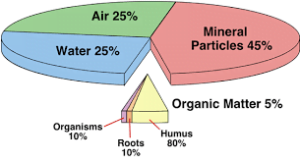Soil Science Short Theory Part 1

Soil:-
Definition:- Soils are natural bodies made from both mineral and organic materials and capable of supporting plants out-of-doors.
Dokuchaiev (1900):- (Father of soil science)- Soil as a natural body composed of mineral and organic constituents, having a definite genesis and a distinct nature of its own.
Jenny (1941):- Soil is a naturally occurring body that has been formed due to combined influence of climate and living organisms acting on parent material as conditioned by relief over a period of time.
Soil is a three dimensional body having length, breadth and depth. They form a continuation over the land surface and differ in properties from place to place. Its upper boundary is air or water and lower boundary is the rock lithosphere.
Composition of soil on volume basis (Soil components)

- Mineral matter: – 45%
- Organic matter: – 5%
- Soil water: – 25%
- Soil air: – 25%
Branch of Soil Science
- Pedology:- Pedology word drive from Greek word pedon, means soil or earth and logos means to study. Pedology concerned with origin of the soil, its classification, distribution and character (Physical, Chemical and Biological).
- Edaphology:- Edaphology word drive from Greek word edaphos, means soilor groundand logos means to study. Edaphology is concerned with the influence of soils on living things, particularly plants.
Soil texture:- Soil texture is the relative proportions of sand, silt, or clay in a soil below 2 mm in diameter (viz. sand, silt and clay). The soil textural class is a grouping of soils based upon these relative proportions.
Three size classes are particularly important:
- Sand (size as in beach sand)
- Silt (size like talc/talcum powder)
- Clay (small particles which stick together, like modeling clay)
- Soils with the finest texture are called clay,
- While soils with the coarsest texture are called sands.
- A soil that has a relatively even mixture of sand, silt, and clay and exhibits the properties from each separate is called a loam.
Particle size classification :-
1. According to International Society of Soil Science (ISSS)
| International Soil Science Society classification | ||
| Separate | Particle Diameter (mm) | |
| 1 | Coarse sand | 2.0 ‑ 0.2 |
| 2 | Fine sand | 0.2 ‑ 0.02 |
| 3 | Silt | 0.02 ‑ 0.002 |
| 4 | Clay | < 0.002 |
2. According to United States Department of Agriculture (USDA)
| USDA Classification | ||
| Separate | Particle Diameter (mm) | |
| 1 | Very coarse sand | 2.0 – 1.0 |
| 2 | Coarse sand | 1.0 – 0.5 |
| 3 | Medium sand | 0.5 – 0.25 |
| 4 | Fine sand | 0.25 – 0.1 |
| 5 | Very fine sand | 0.1 – 0.05 |
| 6 | Silt | 0.05 ‑ 0.002 |
| 7 | Clay | < 0.002 |
More than 2mm particle classified as:-
- Gravels : 2 – 4 mm
- Pebbles : 4 – 64 mm
- Cobbles : 64 – 256 mm
- Boulders : > 256 mm
| Textural Class | Sand (%) | Silt (%) | Clay (%) | |
| 1 | Sandy Soil | 85-100 | 0-15 | 0-10 |
| 2 | Loamy Sand | 70-90 | 0-30 | 0-15 |
| 3 | Sandy Loam | 43-80 | 0-50 | 0-20 |
| 4 | Loam | 23-52 | 28-50 | 07-27 |
| 5 | Silt Loam | 0-50 | 50-88 | 0-27 |
| 6 | Silt | 0-20 | 88-100 | 0-12 |
| 7 | Sand Clay Loam | 45-80 | 0-28 | 20-35 |
| 8 | Clay Loam | 20-45 | 15-53 | 27-40 |
| 9 | Silt Clay Loam | 0-20 | 40-73 | 27-40 |
| 10 | Sandy Clay | 45-65 | 0-20 | 35-45 |
| 11 | Silt Clay | 0-20 | 40-60 | 40-60 |
| 12 | Clay | 0-45 | 0-40 | 40-100 |
| More Soil Science Study Material | Open |
| More Agriculture Study Material | Open |
| Premium Study Material & Test Series | Open |